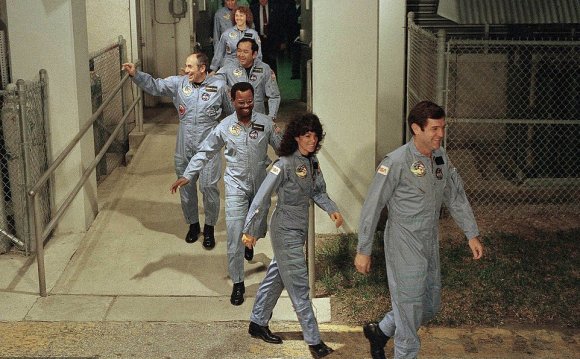
 The shuttle Challenger flight STS-51L crew members who died January 28, 1986. In the back row, from left, mission specialist Ellison S. Onizuka, Teacher in Space Participant Sharon Christa McAuliffe, Payload Specialist Greg Jarvis and Mission specialist Judy Resnik. In the front row, from left, Pilot Mike Smith, Commander Dick Scobee, and Mission specialist Ron McNair.
The shuttle Challenger flight STS-51L crew members who died January 28, 1986. In the back row, from left, mission specialist Ellison S. Onizuka, Teacher in Space Participant Sharon Christa McAuliffe, Payload Specialist Greg Jarvis and Mission specialist Judy Resnik. In the front row, from left, Pilot Mike Smith, Commander Dick Scobee, and Mission specialist Ron McNair.
click image to enlarge
In 2006, Americans commemorated the crew of space shuttle Challenger 20 years after they died while taking off for space on January 28, 1986.Seven crew members, including New Hampshire schoolteacher Christa McAuliffe, had been killed as Challenger blasted upward from Kennedy Space Center.
Challenger disintegrated in the sky just 73 seconds into its flight. The crew died as Challenger exploded in flames while their families watched at Cape Canaveral and millions of others watched via television.
The explosion was blamed on a gas leak in the right booster rocket. The crew module separated from the fireball and dropped on a 2.5-minute free fall from 50, 000 feet into the sea. The crew had no parachutes and there was no way to jettison the hatch.
Later, the presidential commission investigating the accident heard about telephone conferences just hours before launch in which NASA contractor Morton Thiokol's engineers recommended not to launch because their data showed cold temperatures restricted O-ring elasticity. The temperature at launch was 36°F. The commission said Thiokol managers felt pressure from NASA managers to launch so they reversed the engineers' recommendation.
After its deliberations, the presidential commission recommended changes in procedures. The O-ring seal used in solid-fuel booster rockets was redesigned and there have been no seal failures in shuttle flights since then.
Flying in the shuttle Challenger with Christa McAuliffe were commander Francis R. "Dick" Scobee, pilot Michael J. Smith, mission specialists Judith A. Resnik, Ronald E. McNair and Ellison S. Onizuka, and payload specialist Gregory B. Jarvis, an employee of Hughes Aircraft Corp.
Christa McAuliffe had been chosen in 1984 from 11, 000 teachers who had applied to fly on the Challenger mission. The disaster interrupted NASA's plan for spaceflight to become as routine as airplane travel.
RELATED VIDEO




 Anthropogenic hazards or man-made hazards can come to fruition in the form of a man-made disaster. In this case, "anthropogenic" means threats having an element of human intent, negligence, or error; or involving a failure of a man-made system.It results in huge...
Anthropogenic hazards or man-made hazards can come to fruition in the form of a man-made disaster. In this case, "anthropogenic" means threats having an element of human intent, negligence, or error; or involving a failure of a man-made system.It results in huge...








